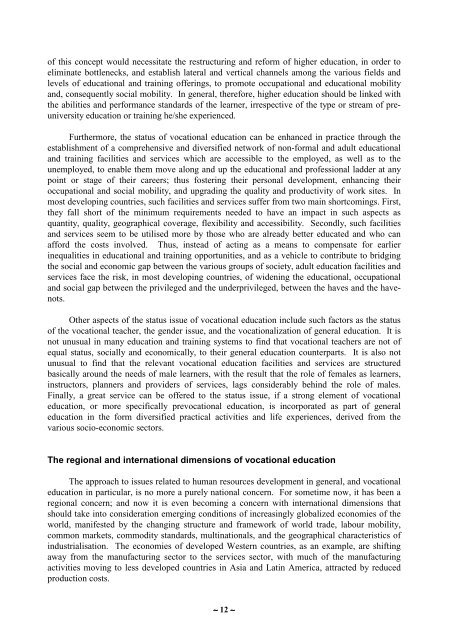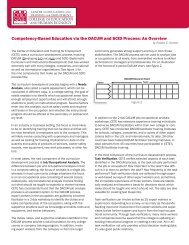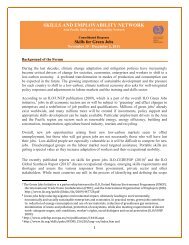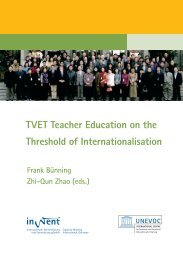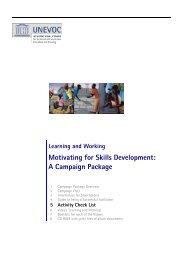Lifelong learning and training: a bridge to the future - Unesco-Unevoc
Lifelong learning and training: a bridge to the future - Unesco-Unevoc
Lifelong learning and training: a bridge to the future - Unesco-Unevoc
You also want an ePaper? Increase the reach of your titles
YUMPU automatically turns print PDFs into web optimized ePapers that Google loves.
of this concept would necessitate <strong>the</strong> restructuring <strong>and</strong> reform of higher education, in order <strong>to</strong><br />
eliminate bottlenecks, <strong>and</strong> establish lateral <strong>and</strong> vertical channels among <strong>the</strong> various fields <strong>and</strong><br />
levels of educational <strong>and</strong> <strong>training</strong> offerings, <strong>to</strong> promote occupational <strong>and</strong> educational mobility<br />
<strong>and</strong>, consequently social mobility. In general, <strong>the</strong>refore, higher education should be linked with<br />
<strong>the</strong> abilities <strong>and</strong> performance st<strong>and</strong>ards of <strong>the</strong> learner, irrespective of <strong>the</strong> type or stream of preuniversity<br />
education or <strong>training</strong> he/she experienced.<br />
Fur<strong>the</strong>rmore, <strong>the</strong> status of vocational education can be enhanced in practice through <strong>the</strong><br />
establishment of a comprehensive <strong>and</strong> diversified network of non-formal <strong>and</strong> adult educational<br />
<strong>and</strong> <strong>training</strong> facilities <strong>and</strong> services which are accessible <strong>to</strong> <strong>the</strong> employed, as well as <strong>to</strong> <strong>the</strong><br />
unemployed, <strong>to</strong> enable <strong>the</strong>m move along <strong>and</strong> up <strong>the</strong> educational <strong>and</strong> professional ladder at any<br />
point or stage of <strong>the</strong>ir careers; thus fostering <strong>the</strong>ir personal development, enhancing <strong>the</strong>ir<br />
occupational <strong>and</strong> social mobility, <strong>and</strong> upgrading <strong>the</strong> quality <strong>and</strong> productivity of work sites. In<br />
most developing countries, such facilities <strong>and</strong> services suffer from two main shortcomings. First,<br />
<strong>the</strong>y fall short of <strong>the</strong> minimum requirements needed <strong>to</strong> have an impact in such aspects as<br />
quantity, quality, geographical coverage, flexibility <strong>and</strong> accessibility. Secondly, such facilities<br />
<strong>and</strong> services seem <strong>to</strong> be utilised more by those who are already better educated <strong>and</strong> who can<br />
afford <strong>the</strong> costs involved. Thus, instead of acting as a means <strong>to</strong> compensate for earlier<br />
inequalities in educational <strong>and</strong> <strong>training</strong> opportunities, <strong>and</strong> as a vehicle <strong>to</strong> contribute <strong>to</strong> bridging<br />
<strong>the</strong> social <strong>and</strong> economic gap between <strong>the</strong> various groups of society, adult education facilities <strong>and</strong><br />
services face <strong>the</strong> risk, in most developing countries, of widening <strong>the</strong> educational, occupational<br />
<strong>and</strong> social gap between <strong>the</strong> privileged <strong>and</strong> <strong>the</strong> underprivileged, between <strong>the</strong> haves <strong>and</strong> <strong>the</strong> havenots.<br />
O<strong>the</strong>r aspects of <strong>the</strong> status issue of vocational education include such fac<strong>to</strong>rs as <strong>the</strong> status<br />
of <strong>the</strong> vocational teacher, <strong>the</strong> gender issue, <strong>and</strong> <strong>the</strong> vocationalization of general education. It is<br />
not unusual in many education <strong>and</strong> <strong>training</strong> systems <strong>to</strong> find that vocational teachers are not of<br />
equal status, socially <strong>and</strong> economically, <strong>to</strong> <strong>the</strong>ir general education counterparts. It is also not<br />
unusual <strong>to</strong> find that <strong>the</strong> relevant vocational education facilities <strong>and</strong> services are structured<br />
basically around <strong>the</strong> needs of male learners, with <strong>the</strong> result that <strong>the</strong> role of females as learners,<br />
instruc<strong>to</strong>rs, planners <strong>and</strong> providers of services, lags considerably behind <strong>the</strong> role of males.<br />
Finally, a great service can be offered <strong>to</strong> <strong>the</strong> status issue, if a strong element of vocational<br />
education, or more specifically prevocational education, is incorporated as part of general<br />
education in <strong>the</strong> form diversified practical activities <strong>and</strong> life experiences, derived from <strong>the</strong><br />
various socio-economic sec<strong>to</strong>rs.<br />
The regional <strong>and</strong> international dimensions of vocational education<br />
The approach <strong>to</strong> issues related <strong>to</strong> human resources development in general, <strong>and</strong> vocational<br />
education in particular, is no more a purely national concern. For sometime now, it has been a<br />
regional concern; <strong>and</strong> now it is even becoming a concern with international dimensions that<br />
should take in<strong>to</strong> consideration emerging conditions of increasingly globalized economies of <strong>the</strong><br />
world, manifested by <strong>the</strong> changing structure <strong>and</strong> framework of world trade, labour mobility,<br />
common markets, commodity st<strong>and</strong>ards, multinationals, <strong>and</strong> <strong>the</strong> geographical characteristics of<br />
industrialisation. The economies of developed Western countries, as an example, are shifting<br />
away from <strong>the</strong> manufacturing sec<strong>to</strong>r <strong>to</strong> <strong>the</strong> services sec<strong>to</strong>r, with much of <strong>the</strong> manufacturing<br />
activities moving <strong>to</strong> less developed countries in Asia <strong>and</strong> Latin America, attracted by reduced<br />
production costs.<br />
∼ 12 ∼


